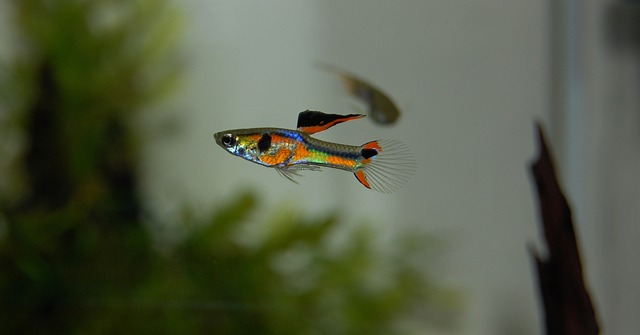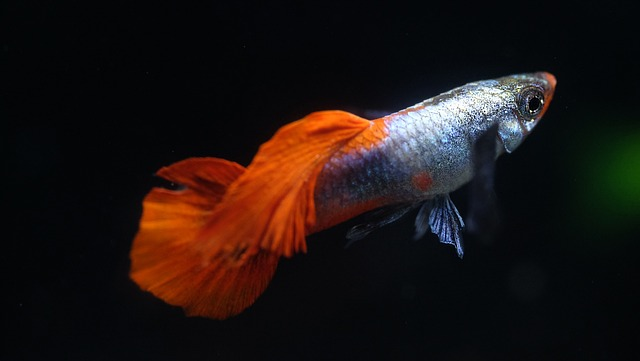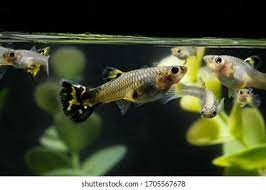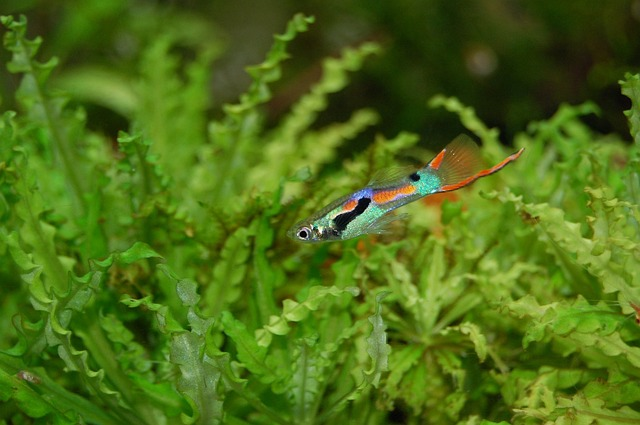Last Updated on 1 year by admin
Is My Guppy Fat Or Pregnant?

If you’re wondering, “Is my guppy fat or pregnant?” you’ve come to the right place. You may have noticed certain changes in your guppy’s behavior or size, or a gravid spot that’s changed color. These are signs of pregnancy.
Changes in guppy’s behavior
You should be aware of the changes in your guppy’s behavior if it becomes pregnant or fat. For example, if your guppy suddenly stops eating, it’s probably pregnant. Usually, a pregnant female will try to hide. It may also isolate itself near a heater or another safe area.
Pregnant females become aggressive toward males and may fin nip. Their breathing will also become faster. Pregnant guppys should be provided with extra care. They should not be overfed. A good food for a pregnant guppy is freeze-dried bloodworms or spirulina flakes.
Pregnant Guppies often exhibit cannibalism and eat their own fry. It is an instinctive behavior. It is also beneficial for the mother since she spends energy protecting her fry. This fat will help her recover the nutrients that she expended to protect her fry.
Changes in guppy’s size
As a female guppy fish becomes pregnant, it will balloon in size. The gravid spot on her belly will change color, becoming darker and wider as the babies grow. The girth of the female guppy will also increase, and her color will start to fade towards the end of pregnancy. When she is close to giving birth, her belly wall may become transparent and her eyes may start to show. Her behavior will change as well, becoming less active, shy, and aggressive.
Larger guppy offspring have higher survival rates. A larger guppy offspring will have an easier time escaping predators, which is the main threat to its survival during the juvenile stage. In order to escape predators, guppies will attempt to swim rapidly, and if they can swim away faster, they are more likely to reach adulthood.
During the mating season, a female guppy will begin acting aggressive. Her aggressive behavior may also indicate pregnancy. She may also start to eat smaller pellets than before and may also start to chew on her tankmates. If you see aggressive behavior during this time, it is time to take your female guppie to the veterinarian.

During the pregnancy period, a pregnant guppy will require four or five small meals throughout the day. She may also require brine shrimp and bloodworms. However, her primary source of nourishment should be high-quality fish flakes.
Changes in guppy’s color
As a guppy grows pregnant, its color will gradually begin to fade. This is part of its natural camouflage instinct. Other signs of pregnancy include a change in eating habits. A female guppy may refuse food or spit it out. She may also breathe more rapidly.
A pregnant guppy will also have an angular belly, which indicates that she is close to giving birth. It may stop eating or spit out food if she is near the end of her pregnancy. If you notice this behavior, it is time to get your guppy a separate tank for the birthing and recovery period.
One of the most common changes to a guppy’s color during pregnancy is the appearance of the gravid spot, which is a dark patch near the female’s anus. This area will turn black as the baby guppies grow inside of it. It may stay red or orange for the first couple of weeks of pregnancy, but will slowly change to a lighter color as the breeding process starts.
Color loss in guppies during pregnancy can be attributed to a variety of reasons. It can be due to stress, disease, poor water conditions, or a poor diet. Regardless of the cause, guppies will eventually regain their original color.
Changing color of gravid spot
When a guppy is pregnant, its gravid spot changes color. This color can be orange or red. It’s located on the rear side of its belly, below the tail. The gravid spot remains orange for a while, but gradually changes to another color as the breeding process begins.
The gravid spot will become darker and larger as the baby grows. The girth of the female will also increase, making her look boxy. It may also start showing the eyes of fry through the belly wall. Once she’s ready to give birth, her behavior will change, becoming more shy and aggressive.
In order to conceive, a female guppy must mate with another female in order to reproduce. During the breeding process, both the male and female will extend their gonopodium fin towards the female. This fin has a tube at the end that conveys the sperm. It can take a few breedings before a female guppy is fertilized.
If you notice the gravid spot in a guppy, make sure you move her to a separate tank. Pregnant guppies are more vulnerable to stress, so it’s important to separate them.
Changes in guppy’s behavior after giving birth
When a guppy is about to give birth, it will look heavily pregnant and will change its behavior. It will try to hide in places where it can’t be disturbed. It will also try to find a quiet place to give birth. The underwater environment can be very dangerous for the babies, so the guppy will look for a safe haven.
After giving birth, a female guppy will produce more young than before. However, some of the babies will die after birth. Others may be stillborn. It is important to check with a reputable fish veterinarian if there is a problem with the babies.
Female guppies give birth in the evening or early morning. The first sign that she is giving birth is a dark spot on her abdomen. The birthing process takes 15 to 30 minutes and will end when all the young have been born. Once the baby is born, the mother will cease to move around.
Once the guppy is pregnant, it is important to remove her from the normal tank and place her in a birthing tank. The birthing tank will provide the safe haven the mother needs to deliver her baby. The mother should be fed a nutritious diet as soon as she is in labor.

Causes of Dropsy in a guppy
The causes of Dropsy in a gupsy are not well known, and the disease may occur in many different fish species. It is characterized by the appearance of a swollen belly with protruding scales. There are many possible causes of this condition, including poor nutrition and stress. It may also be caused by an infection by Aeromonas bacteria, which is common in most fish tanks.
Usually, a fish with dropsy has a poor prognosis, but early treatment can help save the life of a sick fish. Symptoms include a bloated belly and difficulty swimming. The enlarged stomach may also be mistaken for constipation or swim bladder disease.
Other causes include ammonia buildup and inadequate nutrition. This can weaken the immune system and make the guppy vulnerable to various diseases. In some cases, a guppy will develop Dropsy due to an injury or illness. This most commonly occurs during transport to a tank.
When a guppie has Dropsy, its belly will swell up and become bloated. The fish may also refuse to eat or show other symptoms. Its belly may be swollen and curved. If it is unable to eat, it may be suffering from an infection.
Luckily, the causes of Dropsy in a gupsy are easy to treat. The first step is to remove the source of the infection. The infection may be caused by bacteria in the water or by stress. It may also be caused by poor water quality. Make sure you change the water regularly to ensure your guppy is healthy.

Is Guppy fat or bloated?
Apparently guppies are overweight. Obviously you think your baby is pregnant. Guppies are life-giving animals. The eggs are fertilised by the body and then they are born with living fry. But before guppy birth, its stomach will swell and signal fry in the inner intestines. This does not affect female guppies. The males are the only females capable of making birth. Tell me about the case for a female fish? How about guppies with a bloated belly that haven’t given birth or had to be delivered before? Bloating in guppies can be due to many different things other than pregnancy such as:
Dropsy Disease
Drops can occur in several ways. This is the case if the water is not clean or if water levels are low, the water can be toxic or contaminated. The guppy whose Dropsy is used manifests swelling in their belly. Symptoms of this rash typically occur due to bacteria infections. The bacteria responsible for the disease live within the majority of aquariums, although immature species are prone to developing infections. This is causing stomach drops hence the name. [2] So it is possible that Dropsy was bloated when it started swollen.
Pregnancy
If you have gumps that are still bloating and you’re expecting them, you shouldn’t assume pregnancy is causing bloating anymore. The female guppie generally has to meet a female guppie for pregnancy. If this occurs, the eggs on the guppy body will be fertilised using the sperm of an adult male. However female gups can keep these embryos in storage over several months[5]. Moreover, fish are allowed a 28 week cycle even without an adult guppy. It may even cause your baby to become pregnant.
Infections
Infections can cause bowel obstruction by increasing fluid accumulation in the guppy abdomen. This can negatively influence the organs of creatures for a long time. Fish that are exposed to stress in the unsanitary environment are prone to infections. The fish may look light and pale on both occasions and dropsy may look sluggy. A smaller animal may have less appetite for eating and will swim in higher portions of the tank. Fortunately, both types of patients receive identical treatments.

Constipation and indigestion
When your baby is pregnant, it is advisable not to use sand or contaminated foods. Similar to humans, fishes can suffer constipation due to excess consuming of food or from digestive problems[2]. Bloating caused by diarrhoea can cause bladder problems and affect guppy’s swimming ability. It may help with gastrointestinal symptoms, as well as constipation and diarrhoea. They might be stuck in digestive systems. In some species of fish, fecal matter has an unusual length.
Weight gain
Some people have fat due to their appetite. They’ll not be ill or constipated. It’s just that the weight is getting heavier. If the guppy is obese it may indicate that the guppy has a condition. GUPPIES: I am sure they’re very healthy. They don’t lose their appetite, they are lethal. But problems will come later if your animals are fed too many times at once. Ensure that the guppies do not feel hungry so they will eat for as long as they are eaten.
Tumors
Some guppies have tumours or growths. Although tumor cells may form throughout the fish’s body they may also be present in the stomach, which can be fat-bloated. Tumors on the fish are possible from several different reasons including virus viruses like retroviruses. When a tumor appears there may usually be a bulge but there may be no other area. The tumour is benign. Sometimes it doesn’t.
What are pregnant guppy signs of delivery?
The moment when babies are born will be noticed. She’s going to become more reserved to avoid the spotlight if she doesn’t hide. She’s attempting her best to avoid other fish and it’s not easy. It may also occur that she does not eat and just takes the meat out. It’s normal. It doesn’t need much worry. The fish can be 20 to 1000 in number although averages are around 30 – 30. Then if a woman dies, it is important that the mother get her out of the tank. Place the pregnant baby into the separate tank for recovery so the fry is protected.
Tell me the best way to know if a baby is pregnant? Guppy Behavior Before Giving Birth
Tell me the reason for pregnancy? Your baby may have been pregnant with another woman. Its most visible sign is known as gravide spots and is found as dark areas beneath a fish. The guppy gravid area gradually darkens as guppy fry inside pregnant animal grows large. Eventually you might have spotted a small fry eye peeking into it too! The female guppie is a living fish which has the possibility to keep their young within them for weeks following fertilization. Upon guppy fry gaining maturity at an appropriate age they can hatch in the morning and swim with their mother.
Guppy Chasing Behavior
The typical breeding routine for guppy fish is that the male guppy will chase a female and attempt to extend anal fins to gonopodiums and place the eggs in the sexes’ sperm pockets. This is done up to six times during the mating ritual to ensure she is pregnant. Pregnant females can then hold sperm below anal fin for more than a quarter year and can continue getting pregnant.
When a male guppy and a female guppy love each other very much..
If you saw some male guppies start to chase the males around their aquariums, you might be introducing some new species to their family. What might appear to be aggression is actually mating behavior used by adult puppies to show love.
Breeder Box
When you find your pup pregnant, make a breeder’s box available. The Breeders Boxes represent a separate tank in which you move a female after birth and in which you raise the fry.

How to prepare for the guppy babies?
When the pregnancy progresses you must get ready for an upcoming fry. In preparation for guppy fry you have one tank ready when the guppy is born and one for the female guppy for recovery. A tank of 10 gallon is enough. TIP Make sure the conditions of the breeding box match those in your main tank to minimize the strain during pregnancy.
How can I tell pregnant female guppy? Pregnant guppy fish care
Pregnant fish carry babies have just 10 – 20 babies or less. Why do women guppies get so chubby? How to see a pregnant woman? Generally the gravid spot in pregnancy is larger and darker and baby grows larger.
Signs of delivery
When your fish has given birth you can notice some important signs. Depending upon the age and size of the baby fish, the mother may change behavior.

